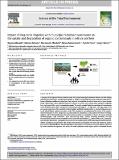Por favor, use este identificador para citar o enlazar a este item:
http://hdl.handle.net/10261/222841COMPARTIR / EXPORTAR:
 SHARE SHARE
 CORE
BASE CORE
BASE
|
|
| Visualizar otros formatos: MARC | Dublin Core | RDF | ORE | MODS | METS | DIDL | DATACITE | |

| Título: | Impact of long-term irrigation with municipal reclaimed wastewater on the uptake and degradation of organic contaminants in lettuce and leek |
Autor: | Manasfi, Rayana; Brienza, Mónica; Ait-Mouheb, Nassim; Montemurro, Nicola CSIC ORCID CVN; Pérez, Sandra; Chiron, Serge | Palabras clave: | Pharmaceuticals Reclaimed wastewater irrigation Plant uptake Risks Soil accumulation |
Fecha de publicación: | 3-oct-2020 | Editor: | Elsevier | Citación: | Science of the Total Environment 142742 (2020) | Resumen: | potential accumulation in soil and leaves and to assess human health related risks. Lettuce and leek crops were selected as a worse-case scenario since leafy green vegetable has a high potential for organic contaminants uptake. The results revealed limited accumulation of contaminants in soil and plant leaves, their concentration levels being in the range of 1–30 ng/g and 1–660 ng/g range in soil and leaves, respectively. This was likely related to abiotic and biotic transformation or simply binding processes in soil, which limited contaminants plant uptake. This assumption was underpinned by studies of the enantiomeric fractionation of chiral compounds (e.g. climbazole and metoprolol) in soil as pieces of evidence of biodegradation and by the identification of transformation products or metabolites in leaves by means of liquid chromatography - high resolution - mass spectrometry using a suspect screening workflow. The high bioconcentration factors were not limited to compounds with intermediate Dow (100 to 1000) such as carbamazepine but also observed for hydrophilic compounds such as clarithromycin, hydrochlorothiazide and the food additives acesulfame and sucralose. This result assumed that accumulation was not only driven by passive processes (e.g. lipoidal diffusion through lipid bilayer cell membranes or Casparian strip) but might be supported by carrier-mediated transporters. As a whole, this study confirmed earlier reports on the a de minimis human health risk related to the consumption of raw leafy green vegetable irrigated with domestic TWW containing organic contaminants residues. | Versión del editor: | https://doi.org/10.1016/j.scitotenv.2020.142742 | URI: | http://hdl.handle.net/10261/222841 | DOI: | 10.1016/j.scitotenv.2020.142742 |
| Aparece en las colecciones: | (IDAEA) Artículos |
Ficheros en este ítem:
| Fichero | Descripción | Tamaño | Formato | |
|---|---|---|---|---|
| 1-s2.0-S0048969720362719-main.pdf | Artículo principal | 1,46 MB | Adobe PDF |  Visualizar/Abrir |
| 1-s2.0-S0048969720362719-mmc1.docx | Material suplementario | 19,64 MB | Microsoft Word XML | Visualizar/Abrir |
CORE Recommender
SCOPUSTM
Citations
23
checked on 12-abr-2024
WEB OF SCIENCETM
Citations
18
checked on 13-feb-2024
Page view(s)
101
checked on 18-abr-2024
Download(s)
112
checked on 18-abr-2024
Google ScholarTM
Check
Altmetric
Altmetric
NOTA: Los ítems de Digital.CSIC están protegidos por copyright, con todos los derechos reservados, a menos que se indique lo contrario.
